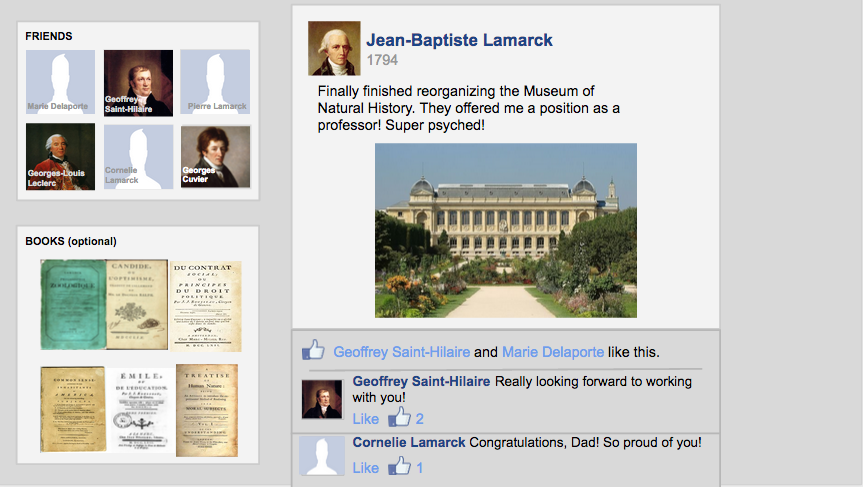Standards Covered:
- Science is a human endeavor; science addresses questions about the natural and material world [NGSS: Appendix NOS].
- Scientists and engineers rely on human qualities such as persistence, precision, reasoning, logic, imagination, and creativity[NGSS: Appendix NOS].
- Scientific knowledge is constrained by human capacity, technology, and materials [NGSS: Appendix NOS]
- Analyze and interpret evidence from the fossil record to infer patterns of environmmental change resulting in extinction and changes to life forms throughout the history of earth [MS-LS4-1].
- Construct and argument using anatomical structures to support evolutionary relationships among and between fossil organisms and modern organisms. Include evidence showing that: a. someo organisms have similar traits with similar functions because they were inherited from a common ancestor, b. some organisms have similar traits that serve similar functions because they live in similar environments, and c. some organisms have traits inherited from common ancestors that no longer serve their original because over time, their environments have changed [MS-LS4-2].
- Explain the mechanism of natural selection, in which genetic variations of some traits in a population increase some individuals' likelihood of surviving and reproducing in a changing environment [MS-LS4-4].
- Synthesize and communicate information about artificial selection, or the ways in which humans have changed the inheritance of desired traits in organisms [MS-LS4-5].
Evolution Standards Tracker:
Lesson 1: Introduction to Evolution. Students will watch a video of Bill Nye explaining evolution and then they will look at slides of different animals and match the ones that are the most closely related.
Lesson 2: History of Evolutionary Theory. Students will have a brief introduction to the history of Evolutionary Theory in which we will discuss Lamarck, Darwin, Wallace, and Mary Treat. We will then discuss the letters that Darwin wrote and use some online sources to fill out Facebook profiles for Charles Darwin, Alfred Russell Wallace, and Mary Treat.
Facebook Template:
Example (Jean-Baptiste Lamarck):
Student Work:
Darwin's Timeline:
Alfred Russel Wallace's Timeline:
Mary Treat's Timeline:
Facebook Organization Chart (to keep track of "friends":
Lesson 3: Adaptations: Part 1. We first gave a brief introduction to adaptations and then students examined the change in population due to adaptations to the environment using the Rock Pocket Mouse simulation.
Rock Pocket Mouse Video:
Rock Pocket Mouse worksheet:
Lesson 4: Adaptations: Part 2. Today we did an evolution simulation game with the students. Each student was a "frog" living on an island (there were 2 islands). There were food items on the tables farther from the students that used sticky hand toys to grab (simulating tongues). The teacher rolled a 6 sided and 12 sided die to see who survived each round (based on "adaptations").
Game Instructions:
Vocabulary Practice:
Lesson 5: Adaptations: Part 3. Today, students created unique organisms that have to survive in a changing environment. We also reviewed vocabulary related to evolution, adaptations, and natural selection.
Choose Your Own Adaptation Activity:
Student Organisms:
Adaptation Assessment:
Lesson 6: Artificial Selection: Students used the activity from: UCMP to breed imaginary dogs and model artificial selection.
Lesson 7: Sexual Selection: Students simulated sexual selection using the “Evolution Dating Game.” In groups of 5, they took on the roles of host, 3 males, and 1 female. They chose a species, and created a script for a “dating game” for that species and made videos of their episodes.
Dating Game Document:
Lesson 8: Selection Writing Task: Students were given a scenario, and had to write a short essay (1-2 paragraphs) about whether the scenario represents Natural Selection, Sexual Selection, or Artificial Selection or a combination and why.
Writing Task Document:
Lesson 9: Students analyzed evidence for evolution based on fossils and embryology. In groups, they sorted paper “fossils” and will filled out the “fossil practice” handout. They also compared and contrasted embryos from different organisms and worked on the “embryology practice” handout.
Fossils Practice:
Embryology Practice:
Lesson 10: Students
analyzed evidence for evolution based on homologous and analogous structures in different species of animals. They colored in homologous structures in skeletons of several species of vertebrates and identified which kinds of similar structures are analogous and which are homologous.
Comparative Anatomy Practice:
Lesson 11: Students analyzed evidence for evolution based on molecular biology. They looked at the amino acids in analogous proteins in different kinds of organisms and identified similarities and differences in the chemical makeup of the proteins as evidence of evolution.
Molecular Biology Practice:
Lesson 12: Students watched the episode of Cosmos on extinction highlighting the two kinds of extinction: Mass Extinction and Background Extinction and filled out an accompanying worksheet. They then participated in an in-class “science talk” on the different causes of extinction and what we can do to prevent modern extinctions.
Video Worksheet:












































What a great web blog . I like this blog because of its design and interface. Private Tutor in Jacksonville It is user friendly and it is nice to visit the blog.
ReplyDelete